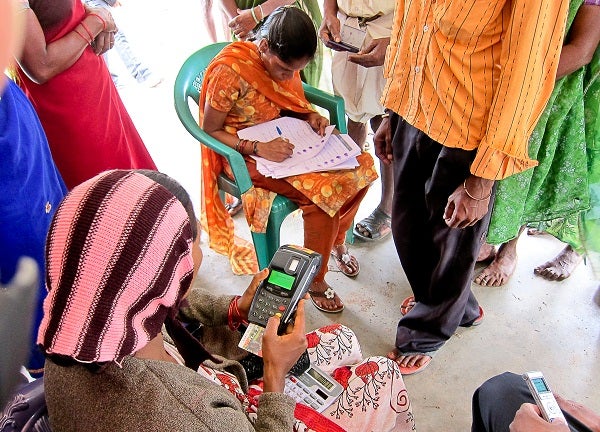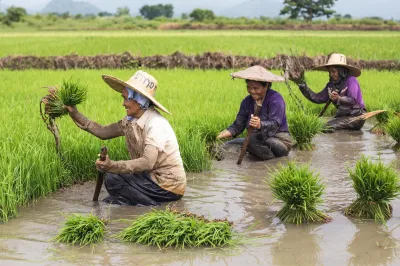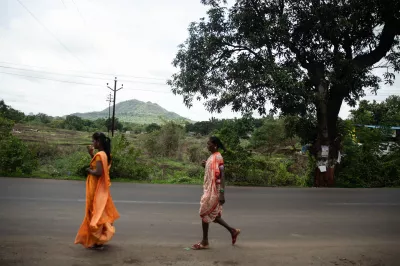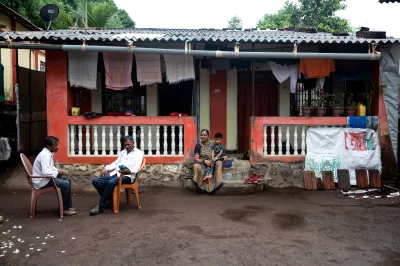Electronic Delivery of Cash Transfers in India: The Agent Story
Janaki from Warangal district is an agent with a private bank. Twenty five years old, she was selected by a banking correspondent company three years ago to disburse social welfare payments ten days out of the month. From the 1st through 6th of every month she disburses social security pensions to the elderly, widowed and disabled. On four other days, throughout the month, she disburses wage payments through the National Rural Employment Guarantee Scheme (NREGA), a national program that guarantees 100 days of work to every household. During the months of May and June, an agriculturally lean season, the volume of wage payments increases dramatically. In those “NREGA peak” months, Janaki disburses Rs 1.5 million ($24,000) worth of cash in one month in her village.
 An agent in India processes payment disbursements
An agent in India processes payment disbursements
Photo Credit: Quicksand
The state of Andhra Pradesh, in the south of India, is home to over 85 million people. Here, social welfare payments are delivered electronically every month to 16 million bank accounts through 26,000 women bank agents. The government has mandated that the agent must be a member of a self-help group (SHG), a women’s only savings group system that is ubiquitous in in rural areas. For many agents, this is their first job and they value the connection with the outside world that this job provides. Janaki and many of her colleagues across the state express that their primary motivation is social service and giving back to the community, and not financial incentives.
In collaboration with the government of Andhra Pradesh, CGAP conducted research on the electronic payment ecosystem in the state. Using mixed methods, the research analyzed demand, supply and policy, with the following question in mind: Could this ecosystem of government-to-person (G2P) payments enable financial inclusion? What are the barriers that prevent account use?
Each month, the funds are transferred from the government to a partner bank which then uses a “banking correspondent” company to enable last mile delivery. The district office of the banking correspondent company withdraws the cash and its staff officers transport the cash on their motorcycles to agents across villages. Every agent has been provided with either a smart card-enabled POS machine, or a mobile NFC (near field communication) device, that can authenticate the beneficiaries’ biometrics. Recently, the state is shifting to a POS machine that links to the UID server to authenticate the biometrics.
The commission structure for agents varies across various models, the most prevalent being a fixed salary of Rs 500 ($8) per month plus a 0.25% commission from each transaction. On average through the year and across models, a G2P agent earns about Rs 1200 ($19) for ten days of work, which is less than the Rs 149 ($2.4) per day minimum wage rate. During the peak transaction period, agents carry out anywhere from 100 to 150 transactions in a day.
Our ethnographic research team followed several agents as they went about their business. They recorded that in many cases an agent seeks the help of a male relative to assist her with crowd management, transporting cash, and handling technological fixes. In remote areas in the north of the state, indigenous communities live in smaller villages, and each agent services 17-18 villages, walking long distances to get to each. This can cause delays in the payments, with recipients often waiting three to four months to receive their funds. Since connectivity is poor, most payments have to be done manually. The agents in these areas struggle with recharging batteries on their POS machines and lack of technical support from the banking correspondent company.
There are several reasons for the weak business case for agents. One major reason is that the commission paid by the government to banks to deliver these payments is less than the costs involved. The banks transfer bulk of that commission to the banking correspondent company that can manage its operational costs albeit the agent remuneration suffers.
Direct Benefit Transfers can help create digital rails, or an ecosystem that can build an agent network that can deliver government payments but also enable remittances and savings for customers. To create a vibrant financial inclusion channel, the income from government payments can guarantee a certain amount of transactions, especially when this network is being developed, but ultimately contribute to 40% or less of that agent’s business. The bigger chunk of the business should come from financial services. That would ensure viability and lesser churn in the agent network.
Even though technically these accounts in Andhra Pradesh are basic savings accounts, none of them are being used by recipients. Because of the way that the current electronic system and incentives are structured, the agent has not been incentivized to offer financial services. Moreover, she would need to be available on most days of the month, and on predictable days, for customers to trust this channel as one that offers financial services. The agent needs to be trained to offer financial services, and remunerated adequately, for this channel to offer quality financial services.
The G2P ecosystem in Andhra Pradesh offers an opportunity to advance financial inclusion, and also offers many lessons as direct benefit transfers are rolled out across the country. In the next five years, India has an ambitious goal of transferring $100 billion worth of subsidies to almost half a billion people electronically. A robust, high quality network of agents can help achieve that goal.
Read our full summary of the research and recommendations here.
Based in New Delhi, Shweta Banerjee leads CGAP’s work on direct benefit transfers in India.




Comments
Dear shweta very nice post. I
Dear shweta very nice post. I workin the knowledge mgmt team at idfc. I read the executive summary of the cgap world bank report linking electronic payments and social cash transfer in india.
Shweta its a very interesting report. Possible to share the complete report with me for my library.
Pl let me know. I tried your mail id contact no but no luck. Kindly reply.
Rgds
Hi Shweta, Thanks for
Hi Shweta, Thanks for bringing out of Agent problems in the G2P system, which is working from last 7yrs. Request to all the readers: keep in mind that the current stage of program has crossed so many problems, starting from depending on PCOs located at Block level to depending on GPRS connectivity. Quality of the program and satisfactory levels of all stake holders of the project are completely depended on the reach and earnings at their levels /stages. If, banks get more flow of funds or if, Govt increases the incentive part then only front end people will be paid better.
Govt has to take initiative or TSP/BC Company has to reduce their profits and share the same to the last mile, then only this program will remain as more trusted/faithful/ highest reached technology initiative.
Best wishes to all stake holders.
Cheers
Adi.
The Agent Story as emerging
The Agent Story as emerging from the Andhra study should make policy makers sit up and take notice of flaws in the model as implemented for B2P in India. It is essential that authorities first solve structural issues so that flow of funds is smooth and safe. Then the economics of Agents should be closely studied and a final view on what should be the reasonable remuneration for Agents should be taken once for all for the present. Customer service standards for agents working should also be listed and accepted, which should dictate the costs and process finalisation. Governments need to consider that the new delivery model must be superior than the earlier ones, otherwise it will lead to beneficiary disenchantment. Such programmes if fail can take the country back in the developmental efforts as the real financial inclusion efforts are to ride over the agent model. Governments should also not be miserly in financially supporting Agent programmes in the first two three years so that they reach scale and get well embedded in the society. International agencies also have to change their approach in supporting Indian efforts in G2P and Financial Inclusion. They must ensure that they convince the state governments in adopting simple transparent models and to undertake mid course corrections wherever necessary.
Business Correspondent companies may also be supported by international agencies financially and at policy levels to put in failsafe procedures for operations by Agents. One of the reasons for weaknesses in Agent models was that such BC companies bid very low rates and got struck therein as the businesses didnot scale up. Many government banks may like to change the terms to better levels for agents, but due to strict Vigilance Commission guidelines can not do it. Sadly many know of the difficulties of agents but can not do much. Problems of Agents as highlighted in the study affect over 100,000 agents working across India.
Finally there is also a need to explore possibility of using as Agents Kirana ( retail stores ) in villages, Common Service Centres ( setup by GOI to offer other G2P services like birth certificates/ land records etc), Shakti Ammas of Hindustan Unilever Ltd., who have additional streams of incomes.
We have not explored using ex soldiers in their native villages as Agents, who again have pensions to support them.
Time has come to think if G2P and financial inclusion need an institution separately than GOI or RBI, as these institutions have very rigid bureaucratic /regulatory regimes, with a mindset to protect the status quo.
India has a long way to go in stabilising agents if it has to catch up with other countries in pursuit of full financial Inclusion by 2020.
( ex General Manager Financial Inclusion, Punjab National Bank New Delhi).
This cash transfer programme
This cash transfer programme can become a model for other emerging democracies when policy implementation flaws already identified are rectified by government and the financial services sector. It is a laudable approach to addressing financial inclusion issues especially in countries where marginalisation of the poor are endemic, and also poverty reduction efforts of government have been greeted by failure.
Add new comment